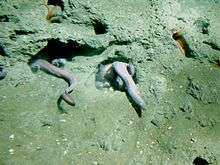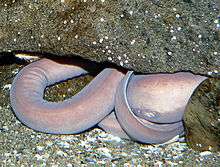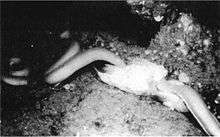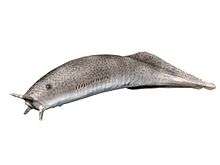Hagfish
| Hagfish | |
|---|---|
 | |
| Pacific hagfish resting on the ocean bottom, at 280 m depth off the Oregon coast | |
| Scientific classification | |
| Kingdom: | Animalia |
| Phylum: | Chordata |
| Subphylum: | Vertebrata |
| Superclass: | Cyclostomata |
| Class: | Myxini |
| Order: | Myxiniformes |
| Family: | Myxinidae Rafinesque, 1815 |
| Genera | |
| |
| Synonyms | |
|
Bdellostomatidae | |
Hagfish, the class Myxini (also known as Hyperotreti), are eel-shaped, slime-producing marine fish (occasionally called slime eels). They are the only known living animals that have a skull but no vertebral column. Along with lampreys, hagfish are jawless; they are the sister group to vertebrates, and living hagfish remain similar to hagfish from around 300 million years ago.[1]
The classification of hagfish has been controversial. The issue is whether the hagfish is a degenerate type of vertebrate-fish (most closely related to lampreys), or represents a stage that precedes the evolution of the vertebral column (as do lancelets). The original scheme groups hagfish and lampreys together as cyclostomes (or historically, Agnatha), as the oldest surviving class of vertebrates alongside gnathostomes (the now-ubiquitous jawed vertebrates). An alternative scheme proposed that jawed vertebrates are more closely related to lampreys than to hagfish (i.e., that vertebrates include lampreys but exclude hagfish), and introduces the category craniata to group vertebrates near hagfish. Recent DNA evidence has supported the original scheme.[2]
Physical characteristics
Body features
Hagfish average about 0.5 m (19.7 in) in length. The largest known species is Eptatretus goliath with a specimen recorded at 127 cm (4 ft 2 in), while Myxine kuoi and Myxine pequenoi seem to reach no more than 18 cm (7.1 in) (some have been seen as small as 4 cm (1.6 in)).
Hagfish have elongated, eel-like bodies, and paddle-like tails. The skin is naked and covers the body like a loosely fitting sock. They have cartilaginous skulls (although the part surrounding the brain is composed primarily of a fibrous sheath) and tooth-like structures composed of keratin. Colors depend on the species, ranging from pink to blue-grey, and black or white spots may be present. Eyes are simple eyespots, not compound eyes that can resolve images. Hagfish have no true fins and have six or eight barbels around the mouth and a single nostril. Instead of vertically articulating jaws like Gnathostomata (vertebrates with jaws), they have a pair of horizontally moving structures with tooth-like projections for pulling off food. The mouth of the hagfish has two pairs of horny, comb-shaped teeth on a cartilaginous plate that protracts and retracts. These teeth are used to grasp food and draw it toward the pharynx.[3]

Slime

Hagfish are long and vermiform, and can exude copious quantities of a milky and fibrous slime or mucus from some 100 glands or invaginations running along its flanks.[4] The typical species Myxine glutinosa was named for this slime. When captured and held, e.g., by the tail, they secrete the microfibrous slime, which expands into up to 20 litres (5¼ gallons) of sticky, gelatinous material when combined with water.[5] If they remain captured, they can tie themselves in an overhand knot, which works its way from the head to the tail of the animal, scraping off the slime as it goes and freeing them from their captor, as well as the slime. This singular behavior may assist them in extricating themselves from the jaws of predatory fish or from the interior of their own "prey", and that the "sliming" might act as a distraction to predators.
Recently, the slime was reported to entrain water in its microfilaments, creating a slow-to-dissipate, viscoelastic substance, rather than a simple gel. It has been proven to impair the function of a predator fish's gills. In this case, the hagfish's mucus would clog up the predator's gills, disabling their ability to breathe. The predator would release the hagfish as it focused less on eating and more on not suffocating. It is because of the mucus that there are very few marine predators that target the hagfish. The other known predators of hagfish are varieties of birds or mammals.[6]
Free-swimming hagfish also "slime" when agitated and later clear the mucus off by way of the same travelling-knot behavior.[7][8] The reported gill-clogging effect suggests that the travelling-knot behavior is useful or even necessary to restore the hagfish's own gill function after "sliming".
Research is ongoing regarding the properties and possible applications of the components of hagfish slime filament protein, particularly as a renewable alternative to synthetics currently derived from petroleum.[4]
Respiration
Hagfish generally respire through taking in water through their pharynx, past the velar chamber and bringing the water through the internal gill pouches, which can vary in number from 5 to 16 pairs, depending on species.[9] The gill pouches open individually, but in Myxine the openings have coalesced, with canals running backwards from each opening under the skin, uniting to form a common aperture on the ventral side known as the branchial opening. The esophagus is also connected to the left branchial opening, which is therefore larger than the right one, through a pharyngocutaneous duct (esophageocutaneous duct), which has no respiratory tissue. This pharyngocutaneous duct is used to clear large particles from the pharynx, a function also partly taking place through the nasopharyngeal canal. In other species the coalescence of the gill openings is less complete, and in Bdellostoma each pouch opens separately to the outside like in lampreys.[10][11] The unidirectional water flow passing the gills is produced by rolling and unrolling velar folds located inside a chamber developed from the naso-hypophyseal tract, and is operated by a complex set of muscles inserting into cartilages of the neurocranium, assisted by peristaltic contractions of the gill pouches and their ducts.[12] Hagfish also have a well-developed dermal capillary network that supplies the skin with oxygen when the animal is buried in anoxic mud, as well as a high tolerance for both hypoxia and anoxia, with a well developed anaerobic metabolism.[13] It has also been suggested that the skin is capable of cutaneous respiration.[14]
Eye
The hagfish's eye, which lacks lens, extraocular muscles, and the three motor cranial nerves (III, IV, and VI), is significant to the evolution of more complex eyes. A parietal eye and the parapineal organ are also absent.[15][16] Hagfish eyespots, when present, can detect light, but as far as is known, none can resolve detailed images. In Myxine and Neomyxine, the eyes are partly covered by the trunk musculature.[3]
Reproduction

Very little is known about hagfish reproduction. Embryos are difficult to obtain for study, although laboratory breeding of the Far Eastern inshore hagfish, Eptatretus burgeri, has succeeded.[17] In some species, sex ratio has been reported to be as high as 100:1 in favor of females. Some hagfish species are thought to be hermaphroditic, having both an ovary and a testicle (there is only one gamete production organ in both females and males). In some cases, the ovary is thought to remain nonfunctional until the individual has reached a particular age or encounters a particular environmental stress. These two factors in combination suggest the survival rate of hagfish is quite high.
Depending on species, females lay from one to thirty tough, yolky eggs. These tend to aggregate due to having Velcro-like tufts at either end. Hagfish are sometimes seen curled around small clutches of eggs. It is not certain if this constitutes actual breeding behavior.
Hagfish do not have a larval stage, in contrast to lampreys, which have a long one.
Hagfish have a mesonephric kidney and are often neotenic of their pronephric kidney. The kidney(s) are drained via mesonephric/archinephric duct. Unlike many other vertebrates, this duct is separate from the reproductive tract. Unlike all other vertebrates, the proximal tubule of the nephron is also connected with the coelom, provided lubrication.
The single testicle or ovary has no transportation duct. Instead, the gametes are released into the coelom until they find their way to the posterior end of the caudal region, whereby they find an opening in the digestive system.
Feeding

While polychaete marine worms on or near the sea floor are a major food source, hagfish can feed upon and often even enter and eviscerate the bodies of dead and dying/injured sea creatures much larger than themselves. They are known to devour their prey from the inside.[18] Hagfish have the ability to absorb dissolved organic matter across the skin and gill, which may be an adaptation to a scavenging lifestyle, allowing them to maximize sporadic opportunities for feeding. From an evolutionary perspective, hagfish represent a transitory state between the generalized nutrient absorption pathways of aquatic invertebrates and the more specialized digestive systems of aquatic vertebrates.[19]
Like leeches, they have a sluggish metabolism and can survive months between feedings;[20][21] their feeding behavior, however, appears quite vigorous. Analysis of the stomach content of several species has revealed a large variety of prey, including polychaetes, shrimps, hermit crabs, cephalopods, brittlestars, bony fishes, sharks, birds and whale flesh.[22]
In captivity, hagfish are observed to use the overhand-knot behavior "in reverse" (tail-to-head) to assist them in gaining mechanical advantage to pull out chunks of flesh from carrion fish or cetaceans, eventually making an opening to permit entry to the interior of the body cavity of larger carcasses. A healthy larger sea creature likely would be able to outfight or outswim this sort of assault.
This energetic opportunism on the part of the hagfish can be a great nuisance to fishermen, as they can devour or spoil entire deep-drag-netted catches before they can be pulled to the surface. Since hagfish are typically found in large clusters on and near the bottom, a single trawler's catch could contain several dozen or even hundreds of hagfish as bycatch, and all the other struggling, captive sea life make easy prey for them.
The digestive tract of the hagfish is unique among the chordates because the food in the gut is enclosed in a permeable membrane, analogous to the peritrophic matrix of insects.[23]
Hagfish have also been observed actively hunting the red bandfish, Cepola haastii, in its burrow, possibly using their slime to suffocate the fish before grasping it with their dental plates and dragging it from the burrow.[24]
Classification
Originally, Myxine was included by Linnaeus (1758) in Vermes. In recent years, hagfish have become of special interest for genetic analysis investigating the relationships among chordates. Their classification as agnathans places hagfish as elementary vertebrates in between invertebrates and gnathostomes. However, there has been long discussion in scientific literature about whether the hagfish were even non-vertebrate. This position is supported by recent molecular biology analyses, which tend to classify hagfish as invertebrates within the subphylum Craniata, because of their molecular evolutionary distance from Vertebrata (sensu stricto). A single fossil of hagfish shows little evolutionary change has occurred in the last 300 million years.[25]
However, the validity of the taxon "Craniata" was recently examined by Delarbre et al. (2002) using mtDNA sequence data, concluding the Myxini are more closely related to Hyperoartia than to Gnathostomata – i.e., that modern jawless fishes form a clade called Cyclostomata. The argument is that if the Cyclostomata are indeed monophyletic, Vertebrata would return to its old content (Gnathostomata + Cyclostomata) and the name Craniata, being superfluous, would become a junior synonym.[2]

| |
| ||||||||||||||||||||||||||||||||||||
| |
Commercial use

As Human Food
Hagfish are not often eaten, owing to their repugnant looks and sliminess. However the inshore hagfish, found in the Northwest Pacific,[26] is valued as food in Korea. The hagfish is kept alive and irritated by rattling its container with a stick, prompting it to produce slime in large quantities. This slime is used in a similar manner as egg whites in various forms of cookery in the region. The inshore hagfish, known as kkomjangeo (꼼장어) or meokjango (먹장어) in Korean and nuta-unagi (ぬたうなぎ) in Japanese, is the only member of the hagfish family with a seasonal reproductive cycle.
Skins
Hagfish skin, used in a variety of clothing accessories, is usually referred to as eel skin. It produces a particularly durable leather, especially suitable for wallets and belts.[27]
References
- ↑ Myxini – University of California Museum of Paleontology
- 1 2 Janvier, P. (2010). "MicroRNAs revive old views about jawless vertebrate divergence and evolution". Proceedings of the National Academy of Sciences. 107 (45): 19137–19138. Bibcode:2010PNAS..10719137J. doi:10.1073/pnas.1014583107.
Although I was among the early supporters of vertebrate paraphyly, I am impressed by the evidence provided by Heimberg et al. and prepared to admit that cyclostomes are, in fact, monophyletic. The consequence is that they may tell us little, if anything, about the dawn of vertebrate evolution, except that the intuitions of 19th century zoologists were correct in assuming that these odd vertebrates (notably, hagfishes) are strongly degenerate and have lost many characters over time
- 1 2 Hyperotreti. Tree of Life
- 1 2 Rothschild, Anna (2013-04-01). "Hagfish slime: The clothing of the future?". BBC News. Retrieved 2013-04-02.
- ↑ "Snotties at Southern Encounter". Southern Encounter Aquarium and Kiwi House. 2007-10-30. Archived from the original on June 7, 2013. Retrieved 2008-10-30.
- ↑ Lim, J; Fudge, DS; Levy, N; Gosline, JM (January 31, 2006). "Hagfish slime ecomechanics: testing the gill-clogging hypothesis". Journal of Experimental Biology. 209 (Pt 4): 702–710. doi:10.1242/jeb.02067. PMID 16449564.
- ↑ Martini, F. H. (1998). "The ecology of hagfishes". In Jørgensen, J. M.; Lomholt, J. P.; Weber, R. E.; Malte, H. The Biology of Hagfishes. London: Chapman and Hall. pp. 57–77. ISBN 0-412-78530-7.
- ↑ Strahan, R. (1963). "The behavior of myxinoids". Acta Zool. 44: 73–102. doi:10.1111/j.1463-6395.1963.tb00402.x.
- ↑ Springer, Joseph; Holley, Dennis (2012). An Introduction to Zoology. Jones & Bartlett Publishers. pp. 376–. ISBN 978-1-4496-9544-6.
- ↑ Hughes, George Morgan (1963). Comparative Physiology of Vertebrate Respiration. Harvard University Press. pp. 9–. ISBN 978-0-674-15250-2.
- ↑ Wake, Marvalee H. (1992). Hyman's Comparative Vertebrate Anatomy. University of Chicago Press. pp. 81–. ISBN 978-0-226-87013-7.
- ↑ Bone, Quentin; Moore, Richard (2008). Biology of Fishes. Taylor & Francis. pp. 128–. ISBN 978-1-134-18631-0.
- ↑ Jørgensen, Jørgen Mørup (1998). The Biology of Hagfishes. Springer Science & Business Media. pp. 231–. ISBN 978-0-412-78530-6.
- ↑ Helfman, Gene; Collette, Bruce B.; Facey, Douglas E.; Bowen, Brian W. (2009). The Diversity of Fishes: Biology, Evolution, and Ecology. John Wiley & Sons. pp. 235–. ISBN 978-1-4443-1190-7.
- ↑ Ostrander, Gary Kent (2000). The Laboratory Fish. Elsevier. pp. 129–. ISBN 978-0-12-529650-2.
- ↑ "Keeping an eye on evolution". PhysOrg.com. 2007-12-03. Retrieved 2007-12-04.
- ↑ Holland, ND (2007). "Hagfish embryos again: The end of a long drought". BioEssays. 29 (9): 833–6. doi:10.1002/bies.20620. PMID 17691082.
- ↑ Wilson, Hugh (November 2009) Hagfish – World's weirdest animals. green.ca.msn.com
- ↑ Glover, CN; Bucking, C; Wood, CM (2011-03-02). "Adaptations to in situ feeding: novel nutrient acquisition pathways in an ancient vertebrate". Proceedings. Biological sciences / the Royal Society. 278 (1721): 3096–101. doi:10.1098/rspb.2010.2784. PMC 3158932
 . PMID 21367787.
. PMID 21367787. - ↑ "Introduction to the Myxini". Berkeley.edu website. Retrieved 2009-01-25.
- ↑ Lesser, M; Martini, Frederic H.; Heiser, John B. (3 January 1997). "Ecology of the hagfish, Myxine glutinosa L. in the Gulf of Maine I. Metabolic rates and energetics". Journal of Experimental Marine Biology and Ecology. 208 (1–2): 215–225. doi:10.1016/S0022-0981(96)02665-2.
- ↑ Zintzen, V.; Rogers, K. M.; Roberts, C. D.; Stewart, A. L.; Anderson, M. J. (2013). "Hagfish feeding habits along a depth gradient inferred from stable isotopes" (PDF). Marine Ecology Progress Series. 485: 223–234. doi:10.3354/meps10341.
- ↑ Piper, Ross (2007), Extraordinary Animals: An Encyclopedia of Curious and Unusual Animals, Greenwood Press.
- ↑ Zintzen, V.; Roberts, C. D.; Anderson, M. J.; Stewart, A. L.; Struthers, C. D.; Harvey, E. S. (2011). "Hagfish predatory behaviour and slime defence mechanism". Scientific Reports. 1. doi:10.1038/srep00131.
- ↑ "Myxinidae Information". Mudminnow Information Services. Archived from the original on July 2, 2008. Retrieved 2010-08-05.
- ↑ "Eptatretus burgeri, Inshore hagfish : fisheries, bait". FishBase.
- ↑ Dillman, Terry (1 February 2013). "Slimed: Ugly Hagfish Yields Somewhat Pretty Income". Fishermen's News.
Further reading
- Froese, Rainer, and Daniel Pauly, eds. (2011). "Myxinidae" in FishBase. February 2011 version.
- Bardack, D (1991). "First fossil hagfish (Myxinoidea): a record from the Pennsylvanian of Illinois". Science. 254 (5032): 701–703. doi:10.1126/science.254.5032.701. PMID 17774799.
- Bardack, D.; Richardson, E. S. Jr (1977). "New agnathous fishes from the Pennsylvanian of Illinois". Fieldiana: Geology. 33: 489–510. doi:10.5962/bhl.title.5167.
- Brodal, A. and Fänge, R. (ed.) (1963). The Biology of Myxine, Universitetsforlaget, Oslo.
- Fernholm, B.; Holmberg, K. (1975). "The eyes in three genera of hagfish (Eptatretus, Paramyxine and Myxine) – A case of degenerative evolution". Vision Research. 15 (2): 253–259. doi:10.1016/0042-6989(75)90215-1. PMID 1129982.
- Hardisty, M. W. (1982). Lampreys and hagfishes: Analysis of cyclostome relationships. In The Biology of Lampreys, (ed. M. W. Hardisty and I. C. Potter), Vol.4B, pp. 165–259. Academic Press, London.
- Janvier, P. (1996). Early vertebrates. Oxford Monographs in Geology and Geophysics, 33, Oxford University Press, Oxford.
- Marinelli, W. and Strenger, A. (1956). Vergleichende Anatomie und Morphologie der Wirberltiere. Myxine glutinosa. Franz Deuticke, Vienna.
- Yalden, D.W. (1985). "Feeding mechanisms as evidence for cyclostome monophyly". Zoological Journal of the Linnean Society. 84 (3): 291–300. doi:10.1111/j.1096-3642.1985.tb01802.x.
- Stock, D. W.; Whitt, G. S. (1992). "Evidence from 18S ribosomal RNA that lampreys and hagfishes form a natural group". Science. 257 (5071): 787–789. doi:10.1126/science.1496398. PMID 1496398.
- Mincarone, Michael M.; Stewart, Andrew L. (2006). "New species Eptatretus goliath". BIOONE Online Journals. 6 (2): 225–229. doi:10.1643/0045-8511(2006)6[225:ANSOGS]2.0.CO;2.
- J.M. Jørgensen, J.P. Lomholt, R.E. Weber and H. Malte (eds.) (1997). The biology of hagfishes. London: Chapman & Hall.
- Delarbre, C; et al. (2002). "Complete Mitochondrial DNA of the Hagfish, Eptatretus burgeri: The Comparative Analysis of Mitochondrial DNA Sequences Strongly Supports the Cyclostome Monophyly". Molecular Phylogenetics and Evolution. 22 (2): 184–192. doi:10.1006/mpev.2001.1045. PMID 11820840.
- Bondareva and Schmidt; Schmidt, EE (November 2003). "Early Vertebrate Evolution of the TATA-Binding Protein, TBP". Molecular Biology and Evolution. 20 (11): 1932–1939. doi:10.1093/molbev/msg205. PMC 2577151
 . PMID 12885957.
. PMID 12885957. - Ewoldt, R. H., Winegard, T. M. and Fudge D. S. (2010). Non-linear viscoelasticity of hagfish slime. Int. J. Lin. Mech. 46: 627–636.
- Fudge, D. (2001). Hagfishes: Champions of Slime Nature Australia, Spring 2001 ed., Australian Museum Trust, Sydney. pp. 61–69.
- Fudge, D. S.; Gardner, K. H.; Forsyth, V. T.; Riekel, C.; Gosline, J. M. (2003). "The mechanical properties of hydrated intermediate filaments: Insights from hagfish gland thread cells". Biophys. J. 85 (3): 2015–2027. doi:10.1016/S0006-3495(03)74629-3. PMC 1303373
 . PMID 12944314.
. PMID 12944314. - Fudge, D. S.; Hillis, S.; Levy, N.; Gosline, J. M. (2010). "Hagfish slime threads as a biomimetic model for high performance protein fibres" (PDF). Bioinsp. Biomim. 5: 1–8.
- Fudge, D. S.; Levy, N.; Chiu, S.; Gosline, J. M. (2005). "Composition, morphology and mechanics of hagfish slime". J. Exp. Biol. 208 (24): 4613–4625. doi:10.1242/jeb.01963.
- Lim, J.; Fudge, D. S.; Levy, N.; Gosline, J. M. (February 2006). "Hagfish slime ecomechanics: testing the gill-clogging hypothesis". J. Exp. Biol. 209 (4): 702–710. doi:10.1242/jeb.02067. PMID 16449564.
- Winegard, T. M.; Fudge, D. S. (2010). "Deployment of hagfish slime thread skeins requires the transmission of mixing forces via mucin strands". J. Exp. Biol. 213 (8): 1235–1240. doi:10.1242/jeb.038075.
- Zintzen, V; Roberts, CD; Anderson, MJ; Stewart, AL; Struthers, CD; Harvey, ES (2011). "Hagfish predatory behaviour and slime defence mechanism". Scientific Reports. 1: 131. doi:10.1038/srep00131.
External links
| Wikimedia Commons has media related to Myxinidae. |
| Wikisource has the text of the 1905 New International Encyclopedia article Hagfish. |
- FishBase entry for Myxinidae
- Tree of life illustration showing hagfish's relation to other organisms
- YouTube 5+ minute video of Scripps scientist/diver on hagfish
- Metacafe video of a University of Alberta grad student showing slime production of hagfish while in Bamfield, British Columbia
- Beware the hagfish – repeller of sharks 3 News, 28 Oct 2011. Video.
- Hagfish versus sharks : 1-0 Te Papa Blog, 28 October 2011.
- Teen Spots Hagfish-Slurping Elephant Seal – YouTube (2:11)
- What happens when a shark attacks a hagfish – BBC (0:39)
- Vancouver Aquarium Hagfish Slime